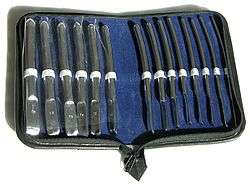Hegar dilators

Hegar dilators are dilators used to induce cervical dilation in order to gain entry to the interior of the uterus. They are metal rods developed by Alfred Hegar. Typically, a set of dilators contains rods of increasing diameters, from a few millimeters up to 26 millimeter. The rods are round, slightly curved and have a conal tip. Some sets have conal tips at both ends, others show one end flattened for handling. Hegar dilators are marked with a Hegar number equivalent to 0.5 millimeter.
During the process of dilation, the cervix may have to be stabilized with a tenaculum, and then the dilators are slowly entered into the cervical canal with a lubricant, starting with a thin, low Hegar number rod and progressing gradually to larger numbers.[1] The dilators can also be used to sound the uterus.
Hegar introduced the dilators in 1879.[2] Hegar dilators are widely used in gynecology to open up the cervix. This may be necessary prior to a uterine curettage or biopsy. They have also found application in the management of vaginismus or hymenal stenosis.[3] They are also used to overcome stenosis in non-gynecological situations, such as in urology and proctology.
Laminaria rods have also been used to open up the cervix but work slowly as they increase size by absorbing water.
References
- ↑ Hellman LM, Pritchard JA. Williams Obstetrics, 14th edition. Appleton Century Croft, 1971. p. 1089f.
- ↑ M Tschoudowski: De la dilatation du canal cervical (d’après Hegar). (1879) Arch Tocol 6: 737–755
- ↑ Segal TR, Fried WB, Krim EY, Parikh D, Rosenfeld DL (2015). "Treatment of microperforate hymen with serial dilation: a novel approach.". J Pediatr Adolesc Gynecol 2015 (Apr),28(2):e21-2. 28: e21–2. doi:10.1016/j.jpag.2014.06.001. PMID 25444056.